This article concerns the period 219 BC – 210 BC.

Year 220 BC was a year of the pre-Julian Roman calendar. At the time it was known as the Year of the Consulship of Laevinus/Catulus and Scaevola/Philo. The denomination 220 BC for this year has been used since the early medieval period, when the Anno Domini calendar era became the prevalent method in Europe for naming years.

Philip V was king of the ancient Greek kingdom of Macedon from 221 to 179 BC. Philip's reign was principally marked by the Social War in Greece and a struggle with the emerging power of the Roman Republic. He would lead Macedon against Rome in the First and Second Macedonian Wars. While he lost the latter, Philip later allied with Rome against Antiochus III in the Roman-Seleucid War. He died in 179 BC from illness after efforts to recover the military and economic condition of Macedonia and passed the throne onto his elder son, Perseus of Macedon.
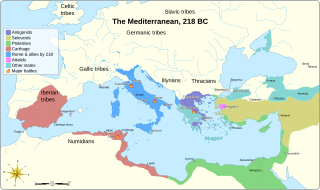
The First Macedonian War was fought by Rome, allied with the Aetolian League and Attalus I of Pergamon, against Philip V of Macedon, contemporaneously with the Second Punic War against Carthage. There were no decisive engagements, and the war ended in a stalemate.
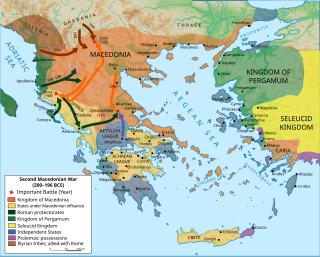
The Second Macedonian War was fought between Macedon, led by Philip V of Macedon, and Rome, allied with Pergamon and Rhodes. Philip was defeated and was forced to abandon all possessions in southern Greece, Thrace and Asia Minor. During their intervention, although the Romans declared the "freedom of the Greeks" against the rule from the Macedonian kingdom, the war marked a significant stage in increasing Roman intervention in the affairs of the eastern Mediterranean, which would eventually lead to Rome's conquest of the entire region.
Publius Sulpicius Galba Maximus was a Roman military officer and Senator who was elected Roman consul twice, and appointed dictator once. He fought in the Second Punic War and the First and Second Macedonian Wars.
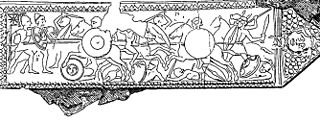
The Battle of Magnesia took place in either December 190 or January 189 BC. It was fought as part of the Roman–Seleucid War, pitting forces of the Roman Republic led by the consul Lucius Cornelius Scipio Asiaticus and the allied Kingdom of Pergamon under Eumenes II against a Seleucid army of Antiochus III the Great. The two armies initially camped northeast of Magnesia ad Sipylum in Asia Minor, attempting to provoke each other into a battle on favorable terrain for several days.

Hellenistic Greece is the historical period of Ancient Greece following Classical Greece and between the death of Alexander the Great in 323 BC and the annexation of the classical Greek Achaean League heartlands by the Roman Republic. This culminated at the Battle of Corinth in 146 BC, a crushing Roman victory in the Peloponnese that led to the destruction of Corinth and ushered in the period of Roman Greece. Hellenistic Greece's definitive end was with the Battle of Actium in 31 BC, when the future emperor Augustus defeated Greek Ptolemaic queen Cleopatra VII and Mark Antony, the next year taking over Alexandria, the last great center of Hellenistic Greece.

Eumenes II Soter was a ruler of Pergamon, and a son of Attalus I Soter and queen Apollonis and a member of the Attalid dynasty of Pergamon.

Philopoemen was a skilled Greek general and statesman, who was Achaean strategos on eight occasions.
Scerdilaidas or Skerdilaid was an Illyrian ruler of the Illyrian kingdom under the Labeatan dynasty. Before taking the throne, Scerdilaidas was commander of the Illyrian armies and played a major role in the Illyrian Wars against the Romans.
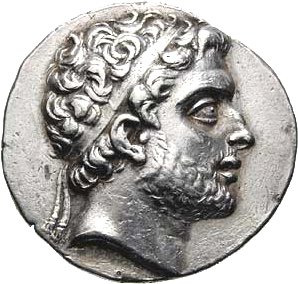
The Battle of Chios was fought in 201 BC between the fleet of Philip V of Macedon and the combined fleet of Rhodes, Pergamum, Byzantium and Cyzicus.
The Second Battle of Lamia was fought in 209 BC between the forces of Philip V of Macedon and Pyrrhias, a general of the Aetolian League. Pyrrhias was once again aided by Pergamene forces and Roman advisors but again he was defeated. His side suffered heavy casualties.
Marcus Valerius Laevinus was a Roman consul and commander who rose to prominence during the Second Punic War and corresponding First Macedonian War. A member of the gens Valeria, an old patrician family believed to have migrated to Rome under the Sabine king T. Tatius, Laevinus played an integral role in the containment of the Macedonian threat.

Attalus I, surnamed Soter, was the ruler of the Greek polis of Pergamon and the larger Pergamene Kingdom from 241 BC to 197 BC. He was the adopted son of King Eumenes I, whom he succeeded, and was the first of the Attalid dynasty to assume the title of king, sometime around 240 to 235 BC. He was the son of Attalus and his wife Antiochis.

The Cretan War was fought by King Philip V of Macedon, the Aetolian League, many Cretan cities and Spartan pirates against the forces of Rhodes and later Attalus I of Pergamum, Byzantium, Cyzicus, Athens, and Knossos.

The Laconian War of 195 BC was fought between the Greek city-state of Sparta and a coalition composed of Rome, the Achaean League, Pergamum, Rhodes, and Macedon.

The Roman–Seleucid war (192–188 BC), also called the Aetolian war, Antiochene war, Syrian war, and Syrian-Aetolian war was a military conflict between two coalitions, one led by the Roman Republic and the other led by the Seleucid king Antiochus III. The fighting took place in modern-day southern Greece, the Aegean Sea, and Asia Minor.
Pyrrhias was an Aetolian general, who was sent by his countrymen during the Social War, to take the command in Elis. Here he took advantage of the absence of Philip V of Macedon, and the incapacity of Eperatus the Achaean strategos, to make frequent incursions into the Achaean territories. Having established a fortified post on Mount Panachaikon, he laid waste the whole country as far as Rhion and Aigion. The next year he concerted a plan with Lycurgus, king of Sparta, for the invasion of Messenia. However, he failed in the execution of his part of the scheme, being repulsed by the Cyparissians before he could effect a junction with Lycurgus. In consequence he returned to Elis, but as the Eleans were dissatisfied with his conduct, he was shortly after recalled by the Aetolians and replaced by Euripidas. At a later period he obtained the office of strategos of the Aetolians, in the same year that this office was bestowed as an honorary title upon Attalus I, king of Pergamon. In the spring of that year he advanced with an army to Lamia to oppose the passage of Philip V of Macedon towards the Peloponnese. Though supported with an auxiliary force both by Attalus and by the Roman praetor Publius Sulpicius Galba Maximus, he was defeated by Philip in two successive battles and forced to retire within the walls of Lamia. It is not improbable that Sipyrrhicas, who appears in Livy (XXXI.46) as chief of the Aetolian deputation which met Attalus at Heracleia, is only a false reading for Pyrrhias.
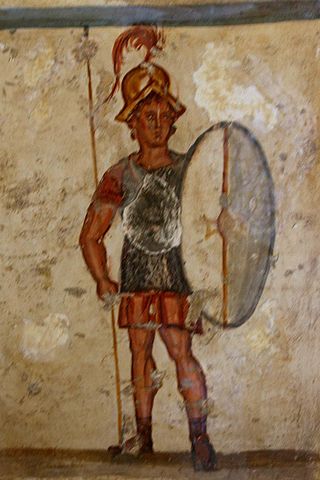
The Antigonid Macedonian army was the army that evolved from the ancient Greek kingdom of Macedonia in the period when it was ruled by the Antigonid dynasty from 276 BC to 168 BC. It was seen as one of the principal Hellenistic fighting forces until its ultimate defeat at Roman hands at the Battle of Pydna in 168 BC. However, there was a brief resurgence in 150-148 during the revolt of Andriscus, a supposed heir to Perseus.













